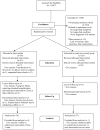Randomized clinical trial of a school-based academic and counseling program for older school-age students
- PMID: 19752672
- PMCID: PMC2884155
- DOI: 10.1097/NNR.0b013e3181b4b60e
Randomized clinical trial of a school-based academic and counseling program for older school-age students
Abstract
Background: Up to 17% of children in the United States have been diagnosed with asthma; children ages 9-14 years experience higher morbidity and mortality compared with other age groups. An academic and counseling program for older elementary students with asthma was developed in collaboration with school personnel, healthcare professionals, and community members: Staying Healthy-Asthma Responsible and Prepared (SHARP). The life span development perspective and the Acceptance of Asthma Model were used to guide development and implementation.
Objectives: This study aimed to establish the preliminary efficacy of SHARP to improve cognitive, behavioral, psychosocial, and quality-of-life outcomes.
Methods: A two-group, longitudinal, prospective, cluster randomized clinical trial design was used. The sample of fourth- to sixth-grade students (N = 66) with asthma aged 9-12 years (M = 10.5, SD = 0.9) was 52% male, was racially diverse (30% Black, 36% White, and 18% biracial), and had a wide range of incomes. Three schools (n = 38 students) were randomized to receive SHARP, and two schools (n = 28 students) were assigned to usual care. Self-report instruments were used.
Results: Compared with the usual care group, statistically significant improvements in the SHARP group were found in student knowledge of asthma, reasoning about asthma, use of risk reduction behaviors, and participation in life activities (p < .01, effect sizes >0.7). Improvements in use of episode management behaviors and acceptance of asthma outcomes were clinically significant with medium effect sizes of 0.3-0.5.
Discussion: The SHARP Student and Community Components demonstrated preliminary efficacy for improving asthma knowledge, reasoning about asthma, use of episode management and risk reduction behaviors, acceptance of asthma in taking control and vigilance, and participation in life activities.
Figures
References
-
- Akinbami L. The state of childhood asthma, United States, 1980-2005. Advance Data. 2006;381:1–24. - PubMed
-
- Akinbami LJ. Asthma prevalence, health care use and mortality: United States, 2003-2005. 2007. Retrieved August 15, 2007, from http://www.cdc.gov/nchs/products/pubs/pubd/hestats/ashtma03-05/asthma03-.... - PubMed
-
- American Academy of Allergy, Asthma, and Immunology Pediatric asthma promoting best practices: Guide for managing asthma in children. 2004. Retrieved August 28, 2004, from http://www.aaai.org/members/resources/initiatives/pediatricasthmaguideli....
-
- American Lung Association. Trends in asthma morbidity and mortality. 2004. Retrieved August 8, 2004 from http://www.getasthmahelp.org/stats_children.asp.
-
- Baltes PB, Reese HW, Lipsitt LP. Life-span developmental psychology. Annual Review of Psychology. 1980;31:65–110. - PubMed



